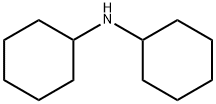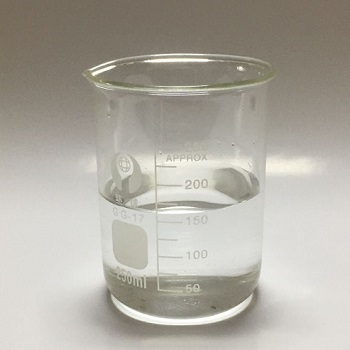
Дициклогексиламин
- английское имяDicyclohexylamine
- CAS №101-83-7
- CBNumberCB6852609
- ФормулаC12H23N
- мольный вес181.32
- EINECS202-980-7
- номер MDLMFCD00011658
- файл Mol101-83-7.mol
| Температура плавления | -2 °C |
| Температура кипения | 256 °C |
| плотность | 0.912 g/mL at 20 °C(lit.) |
| плотность пара | 6 (vs air) |
| давление пара | 12 mm Hg ( 37.7 °C) |
| показатель преломления | n |
| Fp | 205 °F |
| температура хранения | Store below +30°C. |
| растворимость | organic solvents: soluble |
| форма | Crystalline Powder |
| пка | 10.4(at 25℃) |
| цвет | White to off-white |
| РН | 11 (1g/l, H2O, 20℃) |
| Запах | amine odor |
| Пределы взрываемости | 0.8-4.6%(V) |
| Растворимость в воде | 1 g/L (20 ºC) |
| Точка замерзания | -2℃ |
| Чувствительный | Air Sensitive |
| Мерк | 14,3095 |
| БРН | 605923 |
| Стабильность | Stable. Incompatible with strong acids, strong oxidizing agents. |
| ИнЧИКей | XBPCUCUWBYBCDP-UHFFFAOYSA-N |
| LogP | 2.724 at 25℃ |
| Непрямые добавки, используемые в веществах, контактирующих с пищевыми продуктами | DICYCLOHEXYLAMINE |
| Справочник по базе данных CAS | 101-83-7(CAS DataBase Reference) |
| Рейтинг продуктов питания EWG | 1 |
| FDA UNII | 1A93RJW924 |
| Справочник по химии NIST | Cyclohexanamine, N-cyclohexyl-(101-83-7) |
| Система регистрации веществ EPA | Dicyclohexylamine (101-83-7) |
| UNSPSC Code | 12352116 |
| NACRES | NA.22 |
| Коды опасности | C,N | |||||||||
| Заявления о рисках | 22-34-50/53-24/25 | |||||||||
| Заявления о безопасности | 26-36/37/39-45-60-61 | |||||||||
| РИДАДР | UN 2565 8/PG 3 | |||||||||
| WGK Германия | 2 | |||||||||
| RTECS | HY4025000 | |||||||||
| F | 8-9-23 | |||||||||
| Температура самовоспламенения | 240 °C | |||||||||
| TSCA | Yes | |||||||||
| Класс опасности | 8 | |||||||||
| Группа упаковки | III | |||||||||
| кода HS | 29213000 | |||||||||
| Банк данных об опасных веществах | 101-83-7(Hazardous Substances Data) | |||||||||
| NFPA 704: |
|
рисовальное письмо(GHS)
-
рисовальное письмо(GHS)



-
сигнальный язык
опасность
-
вредная бумага
H314:При попадании на кожу и в глаза вызывает химические ожоги.
H410:Чрезвычайно токсично для водных организмов с долгосрочными последствиями.
H301+H311:Токсично при проглатывании или при контакте с кожей.
-
оператор предупредительных мер
P270:При использовании продукции не курить, не пить, не принимать пищу.
P273:Избегать попадания в окружающую среду.
P280:Использовать перчатки/ средства защиты глаз/ лица.
P303+P361+P353:ПРИ ПОПАДАНИИ НА КОЖУ (или волосы): Снять/удалить немедленно всю загрязненную одежду. Промыть кожу водой.
P304+P340+P310:ПРИ ВДЫХАНИИ: Свежий воздух, покой. Немедленно обратиться за медицинской помощью.
P305+P351+P338:ПРИ ПОПАДАНИИ В ГЛАЗА: Осторожно промыть глаза водой в течение нескольких минут. Снять контактные линзы, если Вы ими пользуетесь и если это легко сделать. Продолжить промывание глаз.
Дициклогексиламин химические свойства, назначение, производство
Использование
Dicyclohexylamine (DCHA) is an aliphatic amine. As an intermediate, it can be used in a broad range of applications in different industries.Dicyclohexylamine is used as a vulcanization accelerator.
In lubricants and cutting fluids it does function as a corrosion inhibitor. Here it should be mentioned that Dicyclohexylamine does not form Nitrosamines when being used.

Reagent for preparation of crystalline amino acid derivative salts.
Dicyclohexylamine was used to constitute ionic liquid matrices for bacterial analysis in matrix assisted laser desorption/ionisation mass spectrometry.
It was used to develop a new palladium catalyst for Suzuki coupling reaction of aryl bromides with boronic acids.
It was used as extractant in determination of gold(III) by dispersive liquid-liquid microextraction and electrothermal atomic absorption spectrometry.
Методы производства
Several methods are employed for the manufacture of dicyclohexylamine. It can be manufactured by hydrogenation of equimolar amounts of cyclohexanone and cyclohexylamine. Alternatively, dicyclohexylamine can be prepared by vapor phase catalytic hydrogenation of aniline at elevated temperature and pressure. Fractionation of the crude reaction product yields cyclohexylamine, unreacted aniline, and a high boiling residue comprised of N-phenylcyclohexylamine and dicyclohexylamine (Windholz et al 1983).Реакции воздуха и воды
Slightly soluble in water. May be sensitive to air.Профиль реактивности
DCHA reacts with oxidizing agents. Forms crystalline salts with many N-protected amino acids . Neutralizes acids in exothermic reactions to form salts plus water. May be incompatible with isocyanates, halogenated organics, peroxides, phenols (acidic), epoxides, anhydrides, and acid halides. Flammable gaseous hydrogen may be generated in combination with strong reducing agents, such as hydrides.Угроза здоровью
Dicyclohexylamine is a strong irritant to skin and mucous membranes. Direct skin contact with the liquid or vapor should be avoided. Its systemic effects in man include nausea and vomiting, anxiety, restlessness and drowsiness. Individuals repeatedly exposed to this chemical may develop sensitivity to it (HSDB 1988).Пожароопасность
Combustible material: may burn but does not ignite readily. When heated, vapors may form explosive mixtures with air: indoors, outdoors and sewers explosion hazards. Contact with metals may evolve flammable hydrogen gas. Containers may explode when heated. Runoff may pollute waterways. Substance may be transported in a molten form.Промышленное использование
Dicyclohexylamine is a widely used chemical intermediate. It can be used to absorb acidic gases, to preserve rubber latex, to plasticize casein, and to neutralize plant and insect poisons. Metal complexes of dicyclohexylamine are catalysts used in the paint, varnish, and ink industries. Dicyclohexylamine salts of fatty acids and sulfuric acid have soap and detergent properties used in the printing and textile industries. One of the most important uses of dicyclohexylamine is as a vapor phase corrosion inhibitor. It is used to protect packaged or stored ferrous metals from atmospheric corrosion (Schweizer et al 1978).Профиль безопасности
Poison by ingestion and subcutaneous routes. Corrosive. A severe skin and eye irritant. Questionable carcinogen with experimental tumorigenic data. Human mutation data reported. Combustible when exposed to heat or flame; can react with oxidizing materials. To fight fue, use alcohol foam, CO2, dry chemical. When heated to decomposition it emits toxic fumes of NOx. See also CYCLOHEXYLAMINE.Возможный контакт
Dicyclohexylamine salts of fatty acids and sulfuric acid have soap and detergent properties useful to the printing and textile industries. Metal complexes of DI-CHA are used as catalysts in the paint, varnish, the ink industries. Several vapor-phase corrosion inhibitors are solid DI-CHA derivatives. These compounds are slightly volatile at normal temperatures and are used to protect packaged or stored ferrous metals from atmospheric corrosion. Dicyclohexylamine is also used for a number of other purposes: plasticizers, insecticidal formulations; antioxidant in lubricating oils, fuels, and rubber; and as an extractant. Incompatibilities: Contact with strong oxidizers can cause fire and explosion hazardМетаболизм
The extensive use of cyclamates as artificial sweeteners a number of years ago led to extensive study on the metabolism and carcinogenicity of cyclohexylamine, a metabolic product of cyclamate. However, there is little such information available concerning dicyclohexylamine. Filov (1968) investigated the metabolism of cyclohexylamine and dicyclohexylamine. Both amines were readily absorbed from the gastro-intestinal tract. In addition, they rapidly entered the bloodstream following inhalation and penetrated intact skin. In rats, it was determined that 26-44% of dicyclohexylamine present in the stomach was eliminated unchanged, mostly in the urine. The clearance rate of the amines was also quite high, particularly for dicyclohexylamine.Перевозки
UN2565 Dicyclohexylamine, Hazard class: 8; Labels: 8-Corrosive materialНесовместимости
Dicyclohexylamine salts of fatty acids and sulfuric acid have soap and detergent properties useful to the printing and textile industries. Metal complexes of DI-CHA are used as catalysts in the paint, varnish, the ink industries. Several vapor-phase corrosion inhibitors are solid DI-CHA derivatives. These compounds are slightly volatile at normal temperatures and are used to protect packaged or stored ferrous metals from atmospheric corrosion. Dicyclohexylamine is also used for a number of other purposes: plasticizers, insecticidal formulations; antioxidant in lubricating oils, fuels, and rubber; and as an extractant. Incompatibilities: Contact with strong oxidizers can cause fire and explosion hazardУтилизация отходов
Incineration; incinerator equipped with a scrubber or thermal unit to reduce nitrogen oxides emissions.Дициклогексиламин запасные части и сырье
сырьё
запасной предмет
- N, N-Дициклогексил-2-бензотиазолсульфенамид
- Dicyclohexylammonium nitrite
- Solvent Red 30
- Дициклогексилкарбодиимид
- N-этилциклогексиламин
1of3
Дициклогексиламин поставщик
| поставщик | телефон | страна | номенклатура продукции | благоприятные условия | |
|---|---|---|---|---|---|
| +86-13806087780 | China | 17365 | 58 | ||
| +86-86-5926051114 +8618959220845 |
China | 6383 | 58 | ||
| +86-0512-62927325 +86-13912786601 |
China | 6 | 58 | ||
| +8615531157085 | China | 8804 | 58 | ||
| +86 13288715578 +8613288715578 |
China | 12825 | 58 | ||
| +86-13131129325 | China | 5887 | 58 | ||
| +86-0371-55170693 +86-19937530512 |
China | 21632 | 55 | ||
| +86-021-57951555 +8617317452075 |
China | 1803 | 55 | ||
| +undefined-21-51877795 | China | 32965 | 60 | ||
| +86-0551-65418679 +8618949832763 |
China | 2986 | 55 |